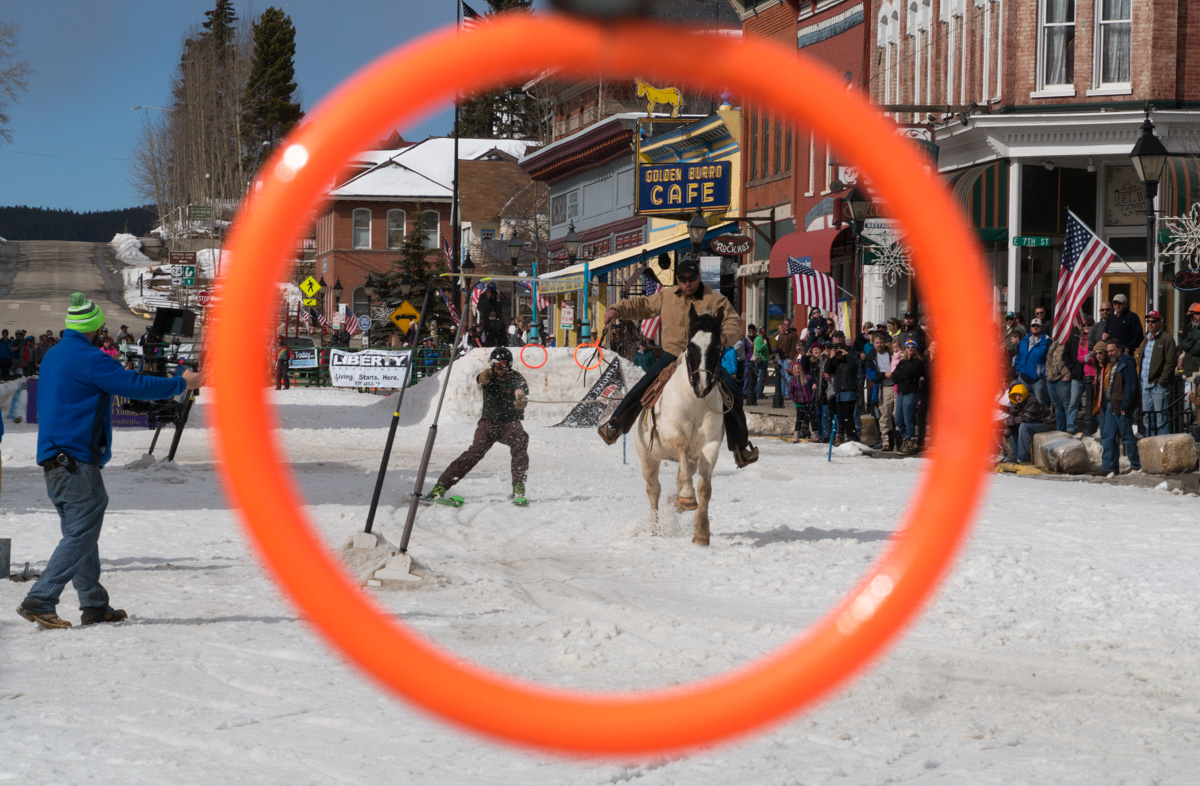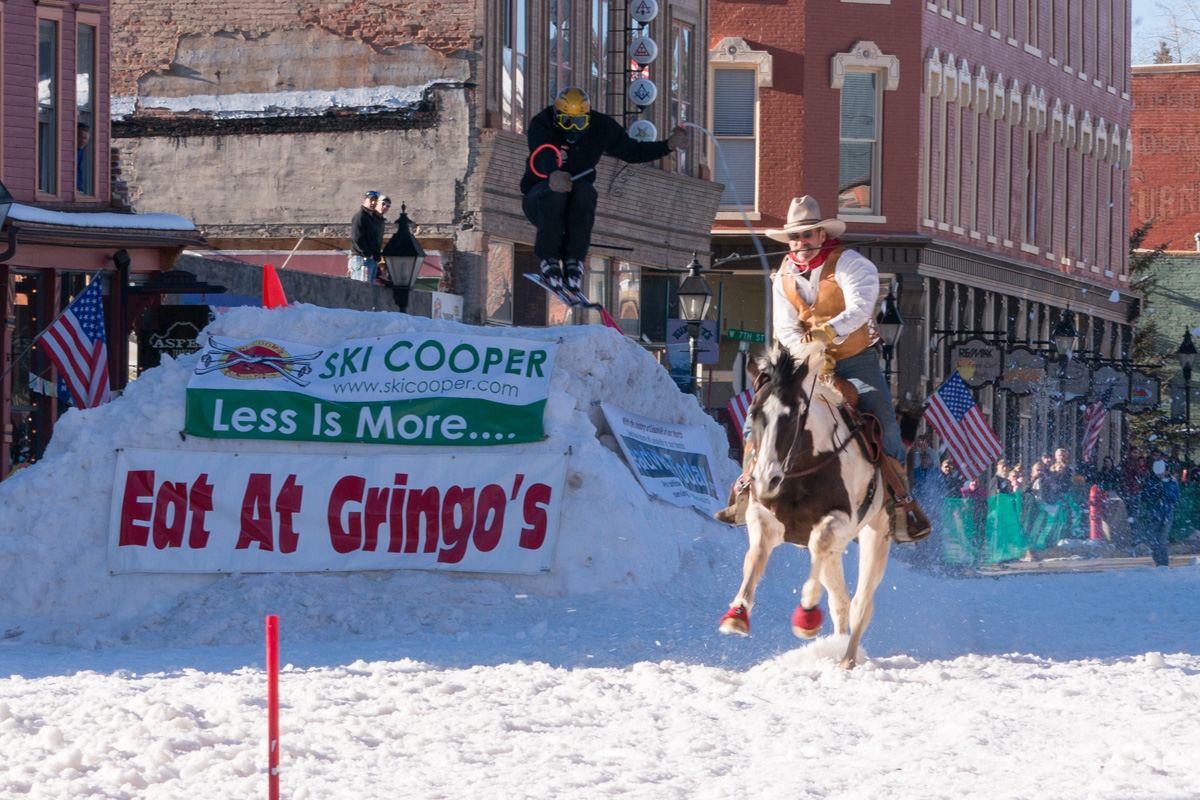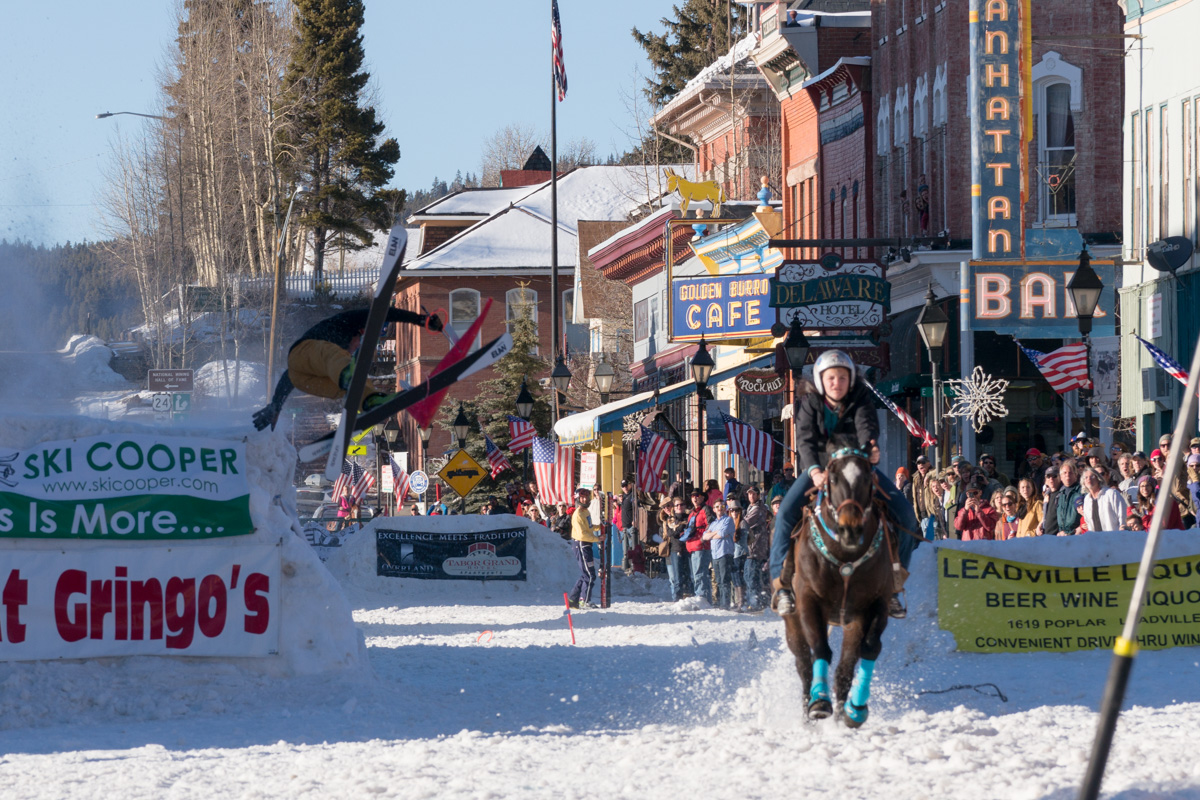
A ring awaits the approaching team of skier Dillon Owen and rider Sotero Bujanda.
Jim Hill/KUNC
"Slack, slack, slack-slack-slack," Lou Dubé yells, spooling out lengths of white rope from behind a horse. One end of the rope is looped on the saddle, the other clutched tight in a skier's hand.
"Whoa, whoa, go-go-go-go-go!"
In three strides, the horse is crashing down a snow-covered street at 40 miles per hour, a helmeted skier in tow.
The skier swoops right, holding a cut-off ski pole in front of him, as if jousting. He rushes through a gate, then aims his ski pole straight at a series of rings hanging from the course. The pole spears the rings; the skier rushes up a jump. He slams up the 8-foot ramp of ice and slush. He sticks the landing. Barely.
The horse barrels ahead. The skier swings wide left. Another gate. Back wide right. More rings. He misses one -- a two-second penalty. Another jump, then across the finish line.
Time: 16 seconds.
This is skijoring, Leadville style. It's the most extreme winter sport you've never heard of.

A ring awaits the approaching team of skier Dillon Owen and rider Sotero Bujanda.
Jim Hill/KUNC
Paul Copper, a tall, broad-faced man who offers up well-practiced one-liners, is the organizer and master of ceremonies behind the race. Leadville being a small town, and skijoring being a small sport, Copper stresses that the event is a team effort, with course builders, race organizers, skiers and riders all coming together to put on the show.
"It's like a big family," said Lou Dubé, the starting-gate rope-holder who also helped build the course. Dubé has been involved in skijoring for decades. "There's probably, oh, I'd say, a couple hundred core people. And Leadville is like a big reunion."
The Leadville race, a straightaway down the town's main street, marks the end of the season and is considered by many to be the "premier, because this was where it started," said Paul Copper.
Leadville skijoring started in 1949, when two residents, Tom Schroeder and Mugs Ossman, were scheming ways to add interest to the town's winter carnival.
"They were sitting in Golden Barrel Cafe just having a cup of coffee and discussing the upcoming carnival," said Copper.
The pair decided to take a trip north to Steamboat Springs to get ideas from their carnival.
"When they came back, they had seen a sport called skijoring."
Steamboat's skijoring was relatively tame, though -- large ranch horses pulling kids on skis, jumps a foot high.
Schroeder, who was a skier, and Ossman, who had quarter horses, came back and practiced in a field.
"They both decided, this is kind of fun, but why in the heck would we want to do it that slow?" said Copper.
"So they sped it up. And that's when they decided to do it full tilt behind the horse, and then build jumps that are quite a bit bigger."

The open class is known for the big jumps, the main was 8-feet tall. Not feeling that brave? The sport class offers jumps of half that height, a more gentle 4-feet.
Jim Hill/KUNC
In Leadville, there are two main races, a sport and an open category. The main difference is that the sport race has smaller jumps, about 4-feet high, and fewer rings. The concept is simple: skiers, pulled by horses, try to get through the course, which consists of gates, rings, and jumps, as fast as possible. Missing a jump or a gate costs you 4 seconds. Dropped rings and batons are a 2-second penalty. You fall, you lose. The fastest team wins cold, hard cash.
Tug Birk, a skier from Eagle, Colorado, has been competing for about 7 years. After he tried it for the first time, "I got hooked," he said. One big difference between downhilling and skijoring: The acceleration is more like a Tesla than a ski run.
"You get going from zero to 35, 40 miles per hour in nothing flat," said Birk.
A former ski racer whose arms looked as they could stretch across the width of the course, Birk said the rings are his nemesis. He wasn't alone. In run after run, skiers missed and dropped rings.
The skier must also cross the finish line both in control and in an upright position. Crashing at the finish disqualifies an otherwise clean run, a hard-learned lesson for some racers.
The sport does not have to involve horses, although that is what Leadville is known for, said Dubé, who, in addition to running the start, also helped design the course.
"Skijoring, essentially, is a person on skis being motivated by either an animal, could be motorcycles, it has been done with cars, even airplanes, believe it or not," Dubé said.
In Europe, skijoring has been around for at least 1,000 years, with reindeer being the original "motivator" in Finland and Lapland. In modern European skijoring, the horses are usually riderless, and are steered by the skier. With the jumps and the high speed, the North American version, perhaps not surprisingly, is more extreme.
"It's a mix of both, the old Western culture, the cowboy, the rodeo, and then the newer ski culture," said Dubé.
Loren Zhimanskova, a historian who discovered the sport a few years back, is fascinated by that cultural mix. She has been working to connect European skijorers with those on the Rocky Mountain circuit.
"I just thought it was an extraordinary sport that combined equestrian aptitude with ski ability," said Zhimanskova.
She just returned from a trip to Europe, where she met their skijoring community. Zhimanskova hopes the cross-pollination will be a boost for the sport. Her sights are set high; skijoring was a demonstration sport in the 1928 Winter Olympics.
"Ultimately, I would like to see skijoring back in the Olympics in some form," she said.
While the sport has plenty of female horseback riders, female skiers are harder to find. Zhimanskova thinks offering women-specific races, as is done in a skijoring competition in Whitefish, Montana, is one way to grow that side of the sport.

Oh no! Did we mention that crashes were common? A skier in the open class takes a tumble off the large jump before rider Savannah McCarty knows what happened.
Jim Hill/KUNC
As the next rider pounds down the Leadville course with a skier trailing, the crowd screams, cowbells jangle, and the announcer -- Paul Copper, of course -- gives play-by-play.
"Over the first jump, into the gate, get the gate, get the gate, get the ring! Get 'em in there!"
A rider's horse goes down, and she falls off. The horse is fine. The rider gets a concussion. She's back the next day to watch, hoping to race again next year.
Skiers crash too, in spectacular, Gumby-like fashion, arms and legs akimbo. Batons are dropped and gates missed. Even for great skiers, it's a challenge.
"Yeah, baby!" Tug Birk skids across the finish line and pumps his fist. At Saturday's race, he dropped a ring. His first run Sunday was clean. (After results were posted, Tug ended up second overall)
Dana Stiles, who pulled Birk on a horse named Newt, was pretty thrilled too.
"Well, my skier said 'yeah baby' at the end of the run, so I think he was clean!"
Before they even catch their breath, Birk and Stiles are headed back towards the start. Meanwhile, another horse is galloping down the course, thrill-seeking skier in tow.